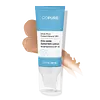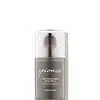What's inside
What's inside
 Key Ingredients
Key Ingredients

 Benefits
Benefits

 Concerns
Concerns

 Ingredients Side-by-side
Ingredients Side-by-side

Zinc Oxide 25%
Cosmetic ColorantWater
Skin ConditioningCaprylic/Capric Triglyceride
MaskingGlycerin
HumectantPropanediol
SolventButyloctyl Salicylate
Skin ConditioningC13-15 Alkane
SolventPolyhydroxystearic Acid
EmulsifyingPolyglyceryl-4 Diisostearate/Polyhydroxystearate/Sebacate
EmulsifyingC9-12 Alkane
SolventIsostearic Acid
CleansingIsoamyl Laurate
EmollientLecithin
EmollientPolyglyceryl-3 Polyricinoleate
EmulsifyingQuaternium-90 Bentonite
Coco-Caprylate/Caprate
EmollientCaprylhydroxamic Acid
Cocos Nucifera Fruit Extract
EmollientVanilla Planifolia Fruit Extract
Skin ConditioningSodium Chloride
MaskingEthyl Vanillin
Masking1,2-Hexanediol
Skin ConditioningGalactoarabinan
Triethyl Citrate
MaskingTocopheryl Acetate
AntioxidantCI 77492
Cosmetic ColorantCI 77491
Cosmetic ColorantCI 77499
Cosmetic ColorantZinc Oxide 25%, Water, Caprylic/Capric Triglyceride, Glycerin, Propanediol, Butyloctyl Salicylate, C13-15 Alkane, Polyhydroxystearic Acid, Polyglyceryl-4 Diisostearate/Polyhydroxystearate/Sebacate, C9-12 Alkane, Isostearic Acid, Isoamyl Laurate, Lecithin, Polyglyceryl-3 Polyricinoleate, Quaternium-90 Bentonite, Coco-Caprylate/Caprate, Caprylhydroxamic Acid, Cocos Nucifera Fruit Extract, Vanilla Planifolia Fruit Extract, Sodium Chloride, Ethyl Vanillin, 1,2-Hexanediol, Galactoarabinan, Triethyl Citrate, Tocopheryl Acetate, CI 77492, CI 77491, CI 77499
Titanium Dioxide 4.8%
Cosmetic ColorantZinc Oxide 9.3%
Cosmetic ColorantCyclomethicone
EmollientWater
Skin ConditioningDimethicone Crosspolymer
Emulsion StabilisingButylene Glycol
HumectantCetyl PEG/PPG-10/1 Dimethicone
EmulsifyingPolymethylsilsesquioxane
Caprylyl Trisiloxane
Skin ConditioningPEG-10 Dimethicone
Skin ConditioningArgania Spinosa Kernel Oil
EmollientGlycerin
HumectantDisteardimonium Hectorite
StabilisingIsododecane
EmollientTocopheryl Acetate
AntioxidantAlumina
AbrasivePyrus Malus Juice
Skin ConditioningCaprylyl Glycol
EmollientEthylhexylglycerin
Skin ConditioningFerric Chloride
AstringentCI 77492
Cosmetic ColorantHelianthus Annuus Flower
Skin ConditioningHexylene Glycol
EmulsifyingLauryl Polyglyceryl-3 Polydimethylsiloxyethyl Dimethicone
Skin ConditioningBisabolol
MaskingMethicone
EmollientPEG/PPG-18/18 Dimethicone
EmulsifyingPhenoxyethanol
PreservativePropylene Carbonate
SolventRice Bran Acid
CleansingRosmarinus Officinalis Water
MaskingSilicon
AbrasiveSodium Chloride
MaskingTocopherol
AntioxidantTriethoxycaprylylsilane
Titanium Dioxide 4.8%, Zinc Oxide 9.3%, Cyclomethicone, Water, Dimethicone Crosspolymer, Butylene Glycol, Cetyl PEG/PPG-10/1 Dimethicone, Polymethylsilsesquioxane, Caprylyl Trisiloxane, PEG-10 Dimethicone, Argania Spinosa Kernel Oil, Glycerin, Disteardimonium Hectorite, Isododecane, Tocopheryl Acetate, Alumina, Pyrus Malus Juice, Caprylyl Glycol, Ethylhexylglycerin, Ferric Chloride, CI 77492, Helianthus Annuus Flower, Hexylene Glycol, Lauryl Polyglyceryl-3 Polydimethylsiloxyethyl Dimethicone, Bisabolol, Methicone, PEG/PPG-18/18 Dimethicone, Phenoxyethanol, Propylene Carbonate, Rice Bran Acid, Rosmarinus Officinalis Water, Silicon, Sodium Chloride, Tocopherol, Triethoxycaprylylsilane
Ingredients Explained
These ingredients are found in both products.
Ingredients higher up in an ingredient list are typically present in a larger amount.
Ci 77492 is also hydrated iron III oxide. It's sole purpose is to give a yellow hue to products.
Iron III oxides are classified as inorganic chemicals for coloring.
Synthetically created Ci 77492 is considered safer than those naturally found. This is because the synthetically created version may contain less impurities. Iron oxides are generally non-toxic and non-allergenic.
Learn more about CI 77492Glycerin is already naturally found in your skin. It helps moisturize and protect your skin.
A study from 2016 found glycerin to be more effective as a humectant than AHAs and hyaluronic acid.
As a humectant, it helps the skin stay hydrated by pulling moisture to your skin. The low molecular weight of glycerin allows it to pull moisture into the deeper layers of your skin.
Hydrated skin improves your skin barrier; Your skin barrier helps protect against irritants and bacteria.
Glycerin has also been found to have antimicrobial and antiviral properties. Due to these properties, glycerin is often used in wound and burn treatments.
In cosmetics, glycerin is usually derived from plants such as soybean or palm. However, it can also be sourced from animals, such as tallow or animal fat.
This ingredient is organic, colorless, odorless, and non-toxic.
Glycerin is the name for this ingredient in American English. British English uses Glycerol/Glycerine.
Learn more about GlycerinChances are, you eat sodium chloride every day. Sodium Chloride is also known as table salt.
This ingredient has many purposes in skincare: thickener, emulsifier, and exfoliator.
You'll most likely find this ingredient in cleansers where it is used to create a gel-like texture. As an emulsifier, it also prevents ingredients from separating.
There is much debate on whether this ingredient is comedogenic. The short answer - comedogenic ratings don't tell the whole story. Learn more about comegodenic ratings here.
The concensus about this ingredient causing acne seems to be divided. Research is needed to understand if this ingredient does cause acne.
Scrubs may use salt as the primary exfoliating ingredient.
Learn more about Sodium ChlorideTocopheryl Acetate is AKA Vitamin E. It is an antioxidant and protects your skin from free radicals. Free radicals damage the skin by breaking down collagen.
One study found using Tocopheryl Acetate with Vitamin C decreased the number of sunburned cells.
Tocopheryl Acetate is commonly found in both skincare and dietary supplements.
Learn more about Tocopheryl AcetateWater. It's the most common cosmetic ingredient of all. You'll usually see it at the top of ingredient lists, meaning that it makes up the largest part of the product.
So why is it so popular? Water most often acts as a solvent - this means that it helps dissolve other ingredients into the formulation.
You'll also recognize water as that liquid we all need to stay alive. If you see this, drink a glass of water. Stay hydrated!
Learn more about WaterZinc Oxide is a mineral broad-spectrum UV filter; it is the broadest UVA and UVB reflector approved by the FDA. It also has skin protectant and skin soothing properties.
Zinc oxide is one of the most effective broad-spectrum UV filters. It protects against UVB, UVAII, and UVAI. In comparison to its counterpart titanium dioxide, zinc oxide provides uniform and extended UVA protection.
Another great benefit? This ingredient is highly photostable so it won't degrade easily under sunlight.
A common myth is that mineral UV filters are widely believed to primarily reflect UV light.
However, modern research shows titanium dioxide absorbs UV radiation like chemical filters (~95% absorption & 5% reflection).
Zinc oxide has great skin soothing properties so you'll likely find this in sunscreens formulated for sensitive skin or babies/children. It is unlikely to cause "eye sting" like other sunscreen ingredients.
Regulatory agencies consider zinc oxide to be non-toxic and safe. It has also been shown to not penetrate the skin.
Unfortunately, this ingredient does leave a visible white cast. This is why mineral sunscreens are often less cosmetically elegant than chemical or hybrid ones.
In cosmetics, zinc oxide can be found in both non-nano and nano-sized forms. The nano version is used to reduce white cast and improve the texture of sunscreen formulas.
There are ongoing concerns surrounding nano-zinc oxide's impact on marine ecosystems and whether it can be absorbed into skin.
Regarding marine ecosystems and coral reefs, there is no conclusive evidence that any form of zinc oxide (or any other sunscreen ingredients) will cause harm. The science is still developing but many consumers are keeping a close eye on this issue.
Please note, many destinations have reef-safety sunscreen rules. For instance, the U.S. Virgin Islands advises all visitors to use non-nano mineral sunscreens.
There has also been some stir about whether micronized or nano zinc oxide has potential photoxicity and absorption through the skin/lungs.
An in-vitro (done in a test tube or petri dish) study demonstrated micronized zinc oxide to have potential phototoxicity. There's no need to fret; the EU Commission's Scientific Committee on Consumer Safety has stated, "The relevance of these findings needs to be clarified by appropriate investigations in vivo." Or in other words, further studies done on living organisms are needed to prove this.
Current research shows zinc oxide nanoparticles do not penetrate intact or sunburned skin. They either remain on the surface or in the outermost layer of dead skin (stratum corneum).
Zinc oxide is one of only two classified mineral UV filters with titanium dioxide being the other one.
Fun fact: Zinc has been used throughout history as an ingredient in paint and medicine. An Indian text from 500BC is believed to list zinc oxide as a salve for open wound. The Ancient Greek physician Dioscorides has also mentioned the use of zinc as an ointment in 1AD.
Learn more about Zinc Oxide